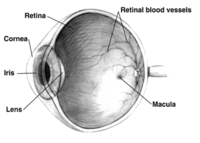
Photo from wikipedia
Optical coherence tomography (OCT) enables noninvasive high-resolution 3D imaging of the human retina, and thus plays a fundamental role in ophthalmology. Via OCT examination, even subtle retinal changes can be… Click to show full abstract
Optical coherence tomography (OCT) enables noninvasive high-resolution 3D imaging of the human retina, and thus plays a fundamental role in ophthalmology. Via OCT examination, even subtle retinal changes can be captured, which occur in very early stages of different diseases (e.g., glaucoma, diabetes mellitus, or age-related macular degeneration). Yet, analyzing the resulting data is challenging. Conventionally, OCT data are strongly aggregated via automated methods. While this reduces the amount of information to be analyzed, it also makes it difficult, if not impossible, to identify small and localized retinal changes. This might lead to wrong diagnoses, since these methods do not account for patient-specific characteristics. We address this problem by providing new and efficient visual-interactive methods. Particularly, we introduce dedicated visualizations that show different aspects of the data. In addition, we support patient-specific selections of relevant data regions. Selected regions are emphasized, or separately visualized to inspect retinal substructures in detail. By visually comparing the regions to reference data, even very small retinal changes can be detected. We demonstrate the utility of our approach by applying it to data of a study with pediatric patients suffering from diabetes mellitus type 1. Our results show that visual-interactive methods indeed help to analyze subtle retinal changes and, thus, support the diagnosis of diseases in an early stage.
Journal Title: Klinische Monatsblatter fur Augenheilkunde
Year Published: 2017
Link to full text (if available)
Share on Social Media: Sign Up to like & get
recommendations!